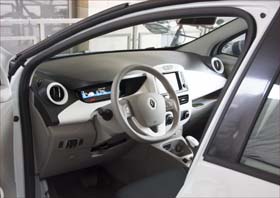
An electric car is currently charging
Possible charging devices in the private household
For the layman, the charging process seems very simple: A power cable connects the socket on the house with the connection in the electric car and the battery charges overnight. Due to the lack of safeguards and the above-mentioned risk of overheating, the Association for Efficient Energy Use (HEA) considers this possibility only for charging small vehicles such as pedelecs or segways. If you want to charge electric cars, you should switch at least one control and protection device between the socket and the battery, as this stops the charging process in case of danger.
One more security level brings the user a permanently installed charging device. The term “Wallbox” hides a device that is in communication with the vehicle and specifies the maximum allowable charging current. The charging process can be considerably shortened by the use of three-phase current (3-phase, 400 Volt voltage) in contrast to the single-phase “Schuko”-socket with 230 Volt mains voltage. When building a new house, the 3-phase connection should be provided in the garage or at the parking space.
The existing electrical installation in the house must be upgraded
Before buying an electric car, the landlord should have the line lengths, conductor cross sections, switches and protective devices checked for continuous current load. Charging devices require their own circuit with their own residual current circuit breaker. Master electrician Bernd Zeilmann recommends the installation of a separate circuit breaker of type B, since the charging process produces harmonics which are not tolerated by the standard type A circuit breaker.
Charging devices with a charging power of more than 4.6 kW must be connected in 3-phase according to the technical connection conditions of the grid operator. By this measure, uneven loads in the low-voltage distribution networks are avoided. If charging devices with a rated power of more than 12 kW are provided, the network operator must agree to the device.
Current flow and charging power determine the charging time
When using a 1-phase circuit with a CEE socket, the typical charging power is 3.7 kW at a current of 16 amperes. The charging process takes at least six to eight hours. If a 3-phase circuit is available, the typical charging power increases up to 22 kW at a current of 32 amperes. The charging time is reduced to about two hours. Even faster charging times promise fast charging devices with direct current (DC). At least 50 kW charging power is achieved. At German motorway service areas, fast-charging devices with an output of up to 350 kW are currently being developed. Experts see this as a risk for the life of the batteries. “Fast charging should only be the exception,” says master electrician Zeilmann and recommends that the battery is only 80% full.
